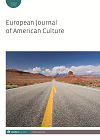- Home
- A-Z Publications
- European Journal of American Culture
- Previous Issues
- Volume 24, Issue 2, 2005
European Journal of American Culture - Volume 24, Issue 2, 2005
Volume 24, Issue 2, 2005
-
-
Editorial: The American culture-industry of image-making; part II
More LessAuthors: Kyriaki Hadjiafxendi and Tatiani RapatzikouiThis special issue aims to map the terrain of the American culture-industry of image-making between the First and Second World Wars. It argues that the attempt to critically understand the challenges that this period had posed to a post-war generation of male writers was not solely a characteristic of a specific high European form of modernism as Jaqueline Fear-Segal and Helen McNeil have argued (1998: 199). Rather, such critical awareness, which coincided with the dream of material success in the 1920s and 1930s, was the product of transatlantic crossings (literal, ideological, metaphorical) between American modernists and their European contemporaries. By focusing on authors from both sides of the Atlantic who manifested a potent masculinity, the articles by John Worthen and Sarah Churchwell suggest that the marketability of modernism constitutes a vital site for the interrogation of gender and sexuality. Their investigation forms the basis of an exploration of image-making as mode of self-positioning before audiences that the next EJAC issue will be examining in greater depth in relation to (post-)modernist aesthetics.
-
-
-
‘Wild Turkeys’: some versions of America by D.H. Lawrence
More LessBy John WorthenD.H. Lawrence’s desire to go to the United States led in 1917-18 to his planning and then writing of the essays that were finally published as Studies in Classic American Literature (1923): all of them were conceived and written with ambivalence. He revised the essays for the last time in New Mexico in the autumn and early winter of 1922, and ‘Americanized’ them for his new American market. In particular, his essay on Walt Whitman now refused to allow the great writer to be an iconic figure. Lawrence’s satirical version of Whitman set out to undermine the seriousness with which Whitman took himself and with which he was generally taken. Lawrence was attacked for his ignorance of American writing, but he had set out to track the American obsession with power and death, satirically; he remained in an uneasy and finally unresolved relationship with American writing.
-
-
-
‘$4000 a screw’: the prostituted art of F. Scott Fitzgerald and Ernest Hemingway
More LessF. Scott Fitzgerald and Ernest Hemingway wrote to and about each other, from their meeting shortly after the publication of The Great Gatsby in 1925, until Hemingway’s A Moveable Feast was published posthumously in 1964. Their correspondence reveals a consistently deployed sexualized discourse in order to trope anxieties about the relationship of masculinity to commercialism and to art. The code these writers developed enabled them to negotiate shifting power relations as they vied with each other to be the better artist, and the more successful man of business. Trying to reconcile high art with commercialism, they sought to manage conflicting cultural ideologies that declared commerce masculine but vulgar, and art feminine but pure. Mixing the language of the Puritan work ethic with sexual metaphors, they measured their success against each other and their culture’s shifting definitions of value. The notorious ‘matter of measurements’ episode in A Moveable Feas only becomes fully legible when it is read within this history of competitive ‘measuring’.
-
-
-
Post-soul futurama: African American cultural politics and early Detroit techno
More LessBy Sean AlbiezTechno is a globally successful genre of electronic dance music that can trace its origins to Detroit in the early 1980s, but it has been generally overlooked in academic, historical and critical analyses of 1980s African American music in the United States. This study will consider the cultural context of early techno, its relationship to European electronic music, the birth of the ‘techno’ genre in the UK, the founding myths and histories of techno, and its potential for helping us understand transformations in African American cultural politics in the ‘postsoul’ era.
-
-
-
Reality consumed by realty: the ecological costs of ‘development’ in Leslie Marmon Silko’s Almanac of the Dead
More LessPublished to coincide with the quincentennial celebrations of Columbus’s ‘discovery’ of the New World, the Native American writer Leslie Marmon Silko’s apocalyptic 1991 novel, Almanac of the Dead, is a harsh highly politicized indictment of 500 years of colonialism, inhumanity and genocide. Silko clearly presents a diverse range of pertinent political issues that are of crucial significance to many contemporary tribal communities within the United States. This article analyses Silko’s concern with ecological issues; with the symbiotic relationship between Native American communities and the land; with the ways in which contemporary exploitation of both Native American lands and their natural resources by the highly powerful energy multinationals are replacing the symbiotic with the parasitic; and with the potential human and ecological costs.
-
Volumes & issues
-
Volume 42 (2023)
-
Volume 41 (2022)
-
Volume 40 (2021)
-
Volume 39 (2020)
-
Volume 38 (2019)
-
Volume 37 (2018)
-
Volume 36 (2017)
-
Volume 35 (2016)
-
Volume 34 (2015)
-
Volume 33 (2014)
-
Volume 32 (2013)
-
Volume 31 (2012)
-
Volume 30 (2011 - 2012)
-
Volume 29 (2010 - 2011)
-
Volume 28 (2009)
-
Volume 27 (2008)
-
Volume 26 (2007 - 2008)
-
Volume 25 (2005 - 2007)
-
Volume 24 (2005)
-
Volume 23 (2004)
-
Volume 22 (2003)
-
Volume 21 (2002)
-
Volume 20 (2001 - 2002)
Most Read This Month


